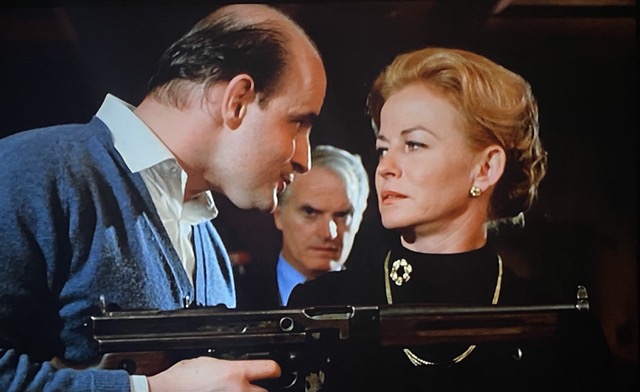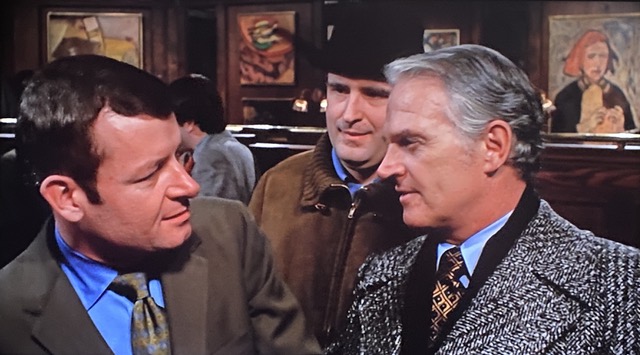| J.R. Jones |

Joe plays on glorious 35mm at the Trylon Cinema from Sunday, May 4th, through Tuesday, May 6th. For tickets, showtimes, and other series information, visit trylon.org.
When John G. Avildsen’s indie drama Joe opened in New York City in July 1970, violence had erupted across the U.S. over President Nixon’s widening of the Vietnam war to include Cambodia. National Guardsmen had killed four student protesters and wounded nine others at Kent State University in Ohio that spring; a few days after this national outrage, more than 200 hundred construction workers in Manhattan, fed up with hippies desecrating the flag, had marched to Wall Street and beaten antiwar demonstrators in an episode that would be dubbed the Hard Hat Riot. Against this political backdrop, Joe—which culminates in an armed assault against a hippie commune—found a wide audience, outgrossing every other independent film that year.1
More than half a century later, Joe reads much differently, speaking to our times as much as its own. Though its story turns on the generational conflict between conservative parents and their liberal daughter, its central relationship is a marriage of convenience between the young woman’s father, who pulls in a handsome salary at a Manhattan advertising agency, and the titlular Joe, a racist, sexist, jingoistic foundry worker with a long list of right-wing grievances: black people gaming the welfare system, liberals pushing a gay lifestyle, rich kids disrespecting their country. Sound familiar? Now that the Vietnam war has faded into a more distant memory, Joe seems less like a commentary than a prophecy, eerily presaging Donald Trump’s courtship of the radical right as he ascended to the presidency.
When Trump campaigned in the primaries in 2016, he liked to throw around the term “silent majority” to explain his unexpected popularity with voters,2 reaching back to the same November 1969 speech by President Richard Nixon that inspired screenwriter Norman Wexler to dream up Joe. After a massive public moratorium against the war, Nixon told his fellow Americans, “As president of the United States, I would be untrue to my oath of office if I allowed the policy of this nation to be dictated by the minority who holds that point of view and who try to impose it on the nation by mounting demonstrations in the street. … And so tonight, to you, the great silent majority, my fellow Americans, I ask for your support.”3
Wexler worked as a copywriter at the upscale D’Arcy Advertising Agency in Manhattan, where one of his co-workers was fledgling filmmaker John Avildsen. While shooting an industrial film together, they discussed Wexler’s idea for Joe, and when Avildsen got the opportunity to direct a low-budget feature for the independent Cannon Films, taking over funds from another project that had collapsed, he managed to sell the company on their story line:4 a middle-class ad exec, traumatized by his hippie daughter’s drug overdose, murders her dope-dealing boyfriend and, stopping at a tavern to steady himself with a drink, impulsively confesses his crime to the title character, initiating a twisted relationship that is part friendship, part class statement, and part blackmail.
Joe offers more than its share of black comedy, and the central joke is Joe himself: for a representative of the silent majority, he’s unbearably, unceasingly loud and judgmental. Avildsen introduces him with a smash cut, jumping from the previous scene to a close-up of our antihero (Peter Boyle) at the American Bar & Grill as he bellows a racial epithet to the long-suffering bartender and any barfly who will listen. “[They’re] getting all the money. Why work? You tell me, why the fuck work when you can screw, have babies, and get paid for it? Welfare. They got all that welfare money! They even get free rubbers. Think they use them? Hell, no! The only way they make money is making babies. They sell the rubbers and then they use the money to buy booze.” Wexler lets Joe keep going until he hangs himself: “If you can’t read, you got a better chance of getting hired. A lot of good my education did me!”

Another diatribe, this one against hippies, prompts ad man Bill Compton (Dennis Patrick) to offer up his boozy, ill-considered confession. They part, but a couple days later, having heard about the dealer’s murder on the news, Joe tracks Compton down at his agency, demanding a meeting. Compton expects to be blackmailed, but Joe assuages his fears, expressing only admiration for Compton’s crime. “I just want to shake your hand,” he says. “I just talk about it. But you did it!” Most parents would want to thank him for getting a drug dealer off the streets, Joe assures him. Compton welcomes this sort of talk, knowing that he needs to keep Joe close, and as his guilt gnaws at him, Joe’s brand of vigilantism salves his conscience. Gradually, Compton is seduced by Joe—but there’s something threatening in the way Joe keeps reminding him that his secret is safe.
Compton’s friendship with Joe has its awkward moments as the two negotiate the class divide. “Guys like us, we don’t often get a chance to talk to each other,” Joe observes. “Find it hard talking to me?” Compton denies it, but Joe doesn’t believe him. The movie’s comic centerpiece is an extended sequence in which Bill and Joan Compton (Audrey Caire), eager to protect Bill’s secret, drop by for an uneasy dinner with Joe and his simple wife, Mary Lou (K. Callan). The white-collar couple and blue-collar couple struggle to find common ground, their forced small talk periodically rocked by Joe’s intolerant remarks and boorish behavior. When Joan uses a word he doesn’t know, Joe snaps, “The what?” Before long, Joe drags Bill downstairs to his wood-paneled man cave to inspect his gun cabinet.
Bill indulges Joe mainly to protect himself, but like Donald Trump, he harbors a populist streak, a deep-seated resentment of the established order, and Joe provides him with a unique opportunity to disrupt it. During their first night on the town, Bill takes Joe to his VIP club and, as a prank, passes him off to a colleague at another agency as that company’s new executive vice president; Joe plays along and bullies the man, insinuating a brutal budget cut. As Bill and Joan drive home from the little dinner party, he reveals that he’s sponsoring Joe for membership in their athletic club. “I wouldn’t mind letting [Joe] sit in on one of our creative sessions and let him tell everybody what a bunch of windbags they are,” he says. “After years of nothing but ad types—Mary Lou, Joe, they’re a refreshing change.” For her part, Joan likens their relationship with Joe to “sitting on a powder keg.”
Norman Wexler knew that feeling: a year after earning an Oscar nomination for Joe, the screenwriter, who was diagnosed as manic depressive, was arrested for threatening President Nixon during a commercial airline flight.5 His screenplay draws much of its tension from the possibility that Joe might turn violent. (“You remember how it felt in the war, when you killed a few of them?” he asks Compton. “You feel bad and you feel good at the same time?”) That same risk of violence played out in the first year of Donald Trump’s presidency when a neo-Nazi drove into a crowd of protesters during a white supremacist rally in Charlottesville, N.C., killing a young woman. Ever loyal to his populist base, the president remarked, “I think there’s blame on both sides. … You also had people that were very fine people on both sides,” words that have dogged him ever since. As it turns out, meeting a guy like Joe is a lot easier than getting rid of him.
Footnotes
1 Larry Powell and Tom Garrett, The Films of John G. Avildsen: Rocky, The Karate Kid and Other Underdogs (Jefferson, N.C.: McFarland & Company, Inc., 11.
2 Sam Sanders, “Trump Champions the ‘Silent Majority,’ but What Does That Mean in 2016?,” National Public Radio, January 22, 2016, www.npr.org/2016/01/22/463884201/trump-champions-the-silent-majority-but-what-does-that-mean-in-2016.
3 Richard M. Nixon, “The Great Silent Majority,” November 3, 1969, para. 42, 49, Voices of Democracy: The U.S. Oratory Project, voicesofdemocracy.umd.edu/nixon-silent-majority-speech-text/.
4 The Films of John G. Avildsen, 17.
5 Ibid., 18.
Edited by Olga Tchepikvoa-Treon
